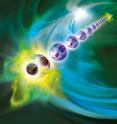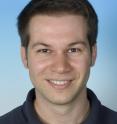Exotic quantum states: A new research approach
Theoretical physicists of the University of Innsbruck have formulated a new concept to engineer exotic, so-called topological states of matter in quantum mechanical many-body systems. They linked concepts of quantum optics and condensed matter physics and show a direction to build a quantum computer which is immune against perturbations. The scientists have published their work in the journal Nature Physics. Three years ago a research team led by Sebastian Diehl and Peter Zoller presented a completely new approach to engineer quantum states in many-body systems. They used a physical phenomenon that normally increases the degree of disorder in a system dramatically: dissipation. In classical physics dissipation is the concept that explains the production of heat through friction. Surprisingly, in quantum physics dissipation can also lead to order and a completely pure many-body state can be realized. This spring an Innsbruck research team, led by experimental physicist Rainer Blatt, demonstrated experimentally that by using dissipation certain quantum effects can be generated and intensified.
By linking concepts of quantum optics and condensed matter physics, theoretical physicists from the Institute of Theoretical Physics of the University of Innsbruck and the Institute for Quantum Optics and Quantum Information of the Austrian Academy of Sciences have now pointed out a new direction of how dissipation may be used in another beneficial and promising way.
Immune against perturbations
In condensed matter physics a new concept to describe order in many-body systems has gained in importance recently: topological order. Two examples for topological phenomena are the quantum Hall effect, which was demonstrated in the 1980s, and the topological insulator, which behaves as an electrical insulator in its interior while permitting the transport of charges on its surface. Sebastian Diehl and Peter Zoller's team of theoretical physicists now suggest realizing dissipation induced Majorana fermions in a quantum system. This topological phenomenon was named after the Italian physicist Ettore Majorana and describes particles that are their own anti-particles.
"We show a new way of how Majorana fermions may be created in a controlled way in a quantum system," explains Sebastian Diehl. "For this purpose we use a dissipative dynamic that drives the system into this state in a targeted way and compels it back when affected by disturbances." With this new approach Diehl and his team combine the advantages of dissipation and topological order -- both concepts are highly robust against perturbations such as disorder. Therefore, their suggestion to create Majorana fermions in an atomic quantum wire is of high interest for experimental implementation. It may be used for building a quantum computer whose basic building blocks consist of Majorana fermions. In quantum wires atoms are confined to one-dimensional structures by optical lattices which are generated by laser beams: Majorana fermions are then generated at both ends of the atomic chain.
Checklist
START awardee Sebastian Diehl and his research group have linked the knowledge of condensed matter physics and quantum mechanics. "We work at the interface between those two disciplines, which creates exciting new possibilities," says Diehl. First though, they had to prove beyond all doubt that the concept of topological order can be transferred to a dissipative context at all. "We were able to tick off all points on the topological checklist and show that its prerequisites are also valid in a system with dissipative dynamics." The physicists have published the mathematical proof of this new approach in the journal Nature Physics.
Source: University of Innsbruck
Other sources
- Nobel Prize 'Inevitable' for Accelerating Universe Discovery, Physicists Sayfrom Live Science13 years ago
- Israel celebrates after chemistry Nobel winfrom Physorg13 years ago
- Iowa State, Ames Laboratory, Technion Scientist Wins Nobel Prize in Chemistryfrom Newswise - Scinews13 years ago
- The 2011 Nobel Prize in Chemistry Honors Discoverer of Quasicrystalsfrom Scientific American13 years ago
- 2011 Nobel Prize in Chemistry: 'Quasicrystals' once thought impossible have changed understanding of solid matterfrom Science Daily13 years ago
- Unusual crystal patterns win chemistry Nobelfrom Sciencenews.org13 years ago
- Israeli Scientist Wins Nobel Prize for Chemistryfrom NY Times Science13 years ago
- Daniel Shechtman wins Nobel chemistry prizefrom MSNBC: Science13 years ago
- Daniel Shechtman wins Nobel chemistry prizefrom Physorg13 years ago
- Shechtman wins 2011 chemistry Nobel for atom pattern workfrom Reuters:Science13 years ago
- Nobel prize in physics 2011 announced - videofrom The Guardian - Science13 years ago
- Nobel win for crystal discoveryfrom BBC News: Science & Nature13 years ago
- Israeli wins chemistry Nobel for quasicrystalsfrom CBC: Technology & Science13 years ago
- Dark energy discovery wins physics Nobelfrom UPI13 years ago
- Physics 'error' leads to Nobel prizefrom LA Times - Science13 years ago
- Nobel in Physics Goes to Perlmutter, Schmidt and Riessfrom NY Times Health13 years ago
- Dark energy discovery wins physics Nobelfrom UPI13 years ago
- Nobel Prize 'Inevitable' for Accelerating Universe Discovery, Physicists Sayfrom Space.com13 years ago
- Nature of universe is still a mystery to Nobel winnersfrom Physorg13 years ago
- Nobel Prize 'Inevitable' for Accelerating Universe Discovery, Physicists Sayfrom Live Science13 years ago
- How Did Nobel-Winning Physicists Discover the Expanding Universe's Accelerationfrom Space.com13 years ago
- Nobel originsfrom Harvard Science13 years ago
- Studies of cosmic expansion win physics Nobelfrom MSNBC: Science13 years ago
- Nobel Prize in Physics: What's Making the Universe Accelerate?from National Geographic13 years ago
- California physicist shares 2011 Nobel Prizefrom Physorg13 years ago
- California physicist shares 2011 Nobel Prizefrom AP Science13 years ago
- Nobel prize for discovery that the universe is accelerating into the voidfrom The Guardian - Science13 years ago
- Video: Nobel Prize in Physics goes to three Americansfrom CBSNews - Science13 years ago
- Dark Energy Wins Nobel Prize in Physicsfrom PopSci13 years ago
- Cosmic acceleration discovery wins physics Nobelfrom Sciencenews.org13 years ago
- Astrophysicist Adam Riess Wins the 2011 Nobel Prize in Physicsfrom Newswise - Scinews13 years ago
- 2011 Nobel Prize in Physics: Discovery of expanding universe by observing distant supernovaefrom Science Daily13 years ago
- Explosive Studies of Universe's Expansion Win Nobel Prize in Physicsfrom Space.com13 years ago
- Explosive Studies of Universe's Expansion Win Nobel Prize in Physicsfrom Live Science13 years ago
- Nobel Prize in Physics Goes to Perlmutter, Schmidt and Riess for Work on Expanding Universefrom NY Times Science13 years ago
- Dark-energy pioneers scoop Nobel prizefrom Physics World13 years ago
- Discovery of Accelerating Universe Wins 2011 Nobel Prize in Physicsfrom Scientific American13 years ago
- Md. prof shares physics Nobel for universe findfrom Physorg13 years ago
- Md. prof shares physics Nobel for universe findfrom AP Science13 years ago
- Dark energy discovery wins physics Nobelfrom Sciencenews.org13 years ago
- Studies of universe's expansion win physics Nobelfrom MSNBC: Science13 years ago
- 3 U.S.-born physicists win Nobel Prizefrom CBSNews - Science13 years ago
- Nobel for expanding Universe findfrom BBC News: Science & Nature13 years ago
- Perlmutter, Schmidt, Riess win Nobel Prize in Physicsfrom CBC: Technology & Science13 years ago
- Three win 2011 physics Nobel for universe expansion workfrom Reuters:Science13 years ago
- Perlmutter, Schmidt, Riess win Nobel physics prizefrom Physorg13 years ago
- Quantum physics is the focus of Nobel buzzfrom Physorg13 years ago
- Quantum physics is the focus of Nobel buzzfrom AP Science13 years ago
- Quantum physics is the focus of Nobel buzzfrom MSNBC: Science13 years ago
- Exotic quantum states: A new research approachfrom Science Daily13 years ago
- Exotic quantum states: A new research approachfrom Physorg13 years ago



